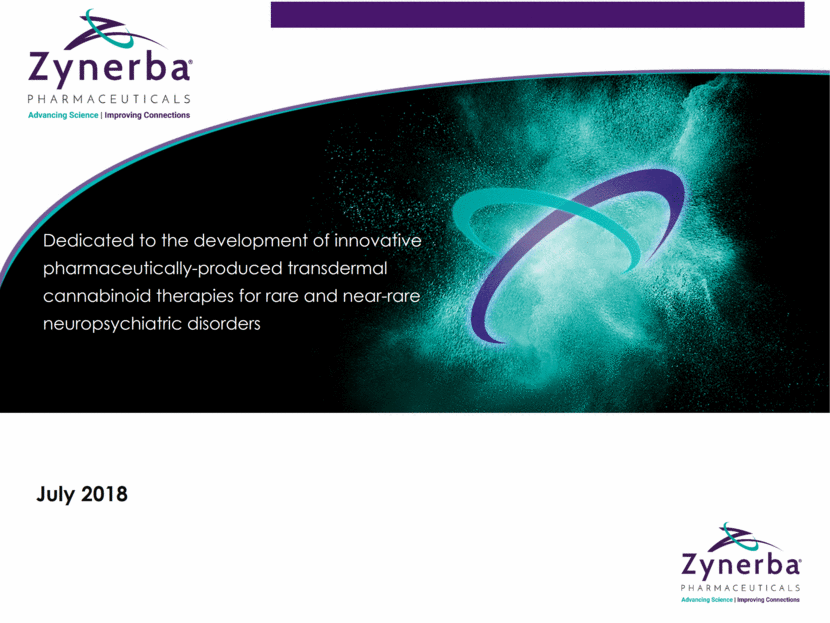Attached files
| file | filename |
|---|---|
| EX-99.1 - EX-99.1 - Zynerba Pharmaceuticals, Inc. | a18-16527_2ex99d1.htm |
| 8-K - 8-K - Zynerba Pharmaceuticals, Inc. | a18-16527_28k.htm |
July 2018 Dedicated to the development of innovative pharmaceutically-produced transdermal cannabinoid therapies for rare and near-rare neuropsychiatric disorders
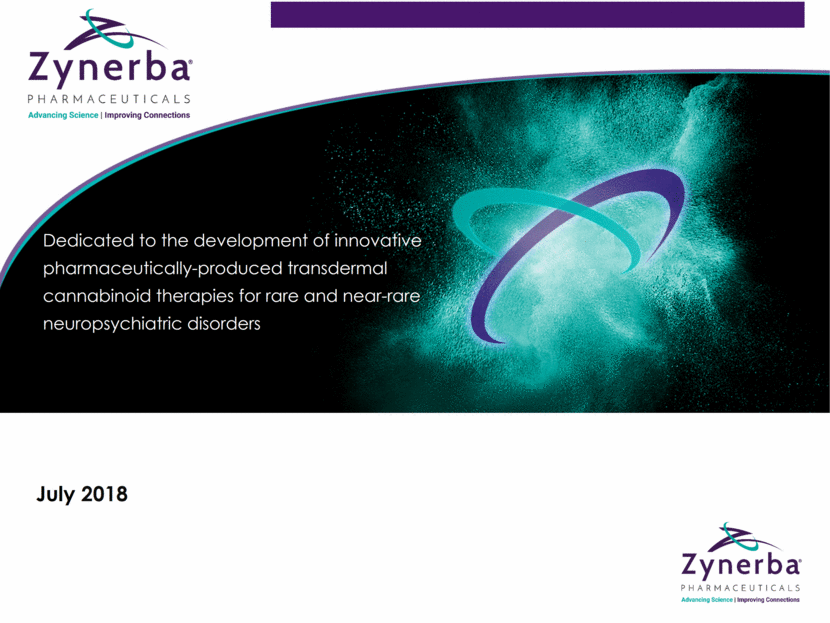
Disclaimer The statements in this presentation may include forward-looking statements within the meaning of Section 27A of the Securities Act of 1933, as amended, and Section 21E of the Securities Exchange Act of 1934, as amended. These statements, among other things relate to the future operations, opportunities or financial performance of Zynerba Pharmaceuticals, Inc. We may, in some cases, use terms such as “predicts,” “believes,” “potential,” “proposed,” “continue,” “estimates,” “anticipates,” “expects,” “plans,” “intends,” “may,” “could,” “might,” “will,” “should” or other words that convey uncertainty of future events or outcomes to identify these forward-looking statements. Such statements are subject to numerous important factors, risks and uncertainties that may cause actual events or results to differ materially from the Company’s current expectations. These and other risks are described in our filings with the Securities and Exchange Commission, available at www.sec.gov. Any forward-looking statements that the Company makes in this presentation speak only as of the date of this PRESENTATION. The Company assumes no obligation to update forward-looking statements whether as a result of new information, future events or otherwise, after the date of this presentation. © 2018 Zynerba Pharmaceuticals, Inc. All rights reserved. Zynerba is a trademark of Zynerba Pharmaceuticals, Inc. All other trademarks and registered trademarks are property of their respective owners. 2

Developing ZYN002 (CBD gel) in rare and near rare neuropsych disorders Focused on high unmet medical needs Fragile X syndrome (FXS): ~71K U.S. patients; no approved products Developmental and epileptic encephalopathies (DEE): ~45K U.S. patients Adult refractory focal epilepsy: ~500K U.S. patients remain uncontrolled on existing AEDs Opportunities for efficient development and commercialization strategy Orphan drug designation provides opportunity for rapid development/approval Other regulatory designations available; if granted, can accelerate approval of drugs meeting criteria Targeted physician audience = modest commercial investment Potential for consistent orphan drug pricing across indications (>$25K per patient per year for ZYN002) Experienced team with proven development and commercialization track record in transdermal delivery, orphan diseases, neurology, and psychiatry Well capitalized with cash runway into the second half of 2019 Multiple expected near term milestones Zynerba Pharmaceuticals A Rare/Near-Rare Neuropsychiatric Company 3

4 Expected 2018 and 2019 Milestones 1Q 2Q 3Q 4Q ZYN002 Fragile X Syndrome FDA meeting DEE Initiate Phase 2 open label study in 1H18 Adult refractory focal epilepsy Initiate new Phase 2B study in 2H18 Present/publish additional data from STAR 2 extension study in 2018 Other indications Assessment of other rare and near-rare neuropsychiatric disorders Initiate Pivotal trial Present/publish additional data from Phase 2 FAB-C study 1Q 2Q 3Q 4Q 2018 2019 Present/publish additional data from Phase 2 FAB-C study Present topline pivotal CONNECT-FX data Present top line Phase 2 BELIEVE-1 data
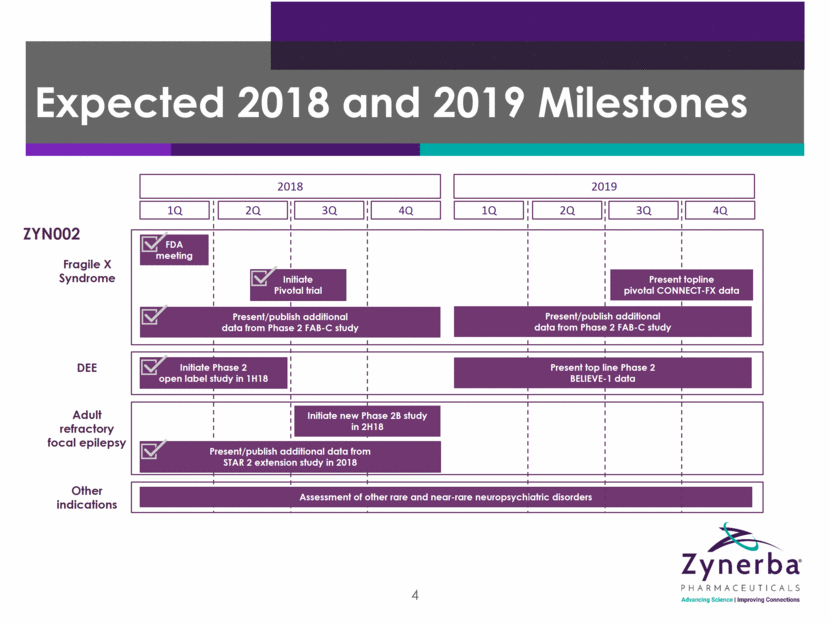
First and only patent-protected permeation-enhanced pharmaceutically-produced cannabidiol (CBD) gel formulated for transdermal delivery CBD binds to multiple receptors and may mediate a number of pathways, including the endocannabinoid pathway Patented formulation increases the delivery of CBD through the layers of the epidermis and into the circulatory system 5 CBD Transdermal gel delivery ZYN002 Cannabidiol (CBD) Gel
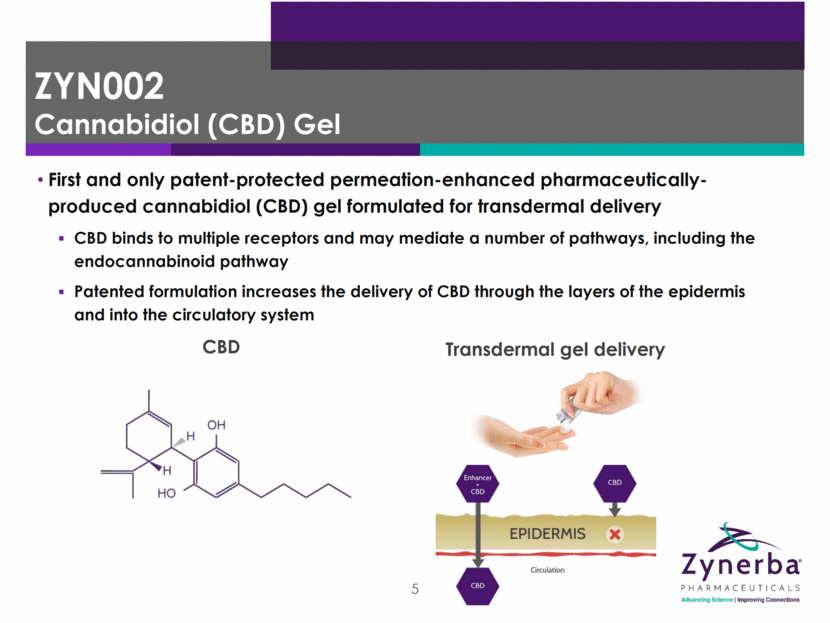
Rare genetic developmental disability; leading known cause of both inherited intellectual disability and autism spectrum disorder Symptoms linked to deficiencies in the endocannabinoid system ECs form system of neurotransmitters regulating emotional responses, behavioral reactivity to context, social interaction FMR1 mutation in FXS causes dysregulation of the EC system resulting in significant social, behavioral, and cognitive deficits Modulation of EC system with CBD may have therapeutic potential in ameliorating some of those symptoms Strong scientific rationale in FXS validated by Phase 2 FAB-C clinical data 6 U.S. Orphan Drug Designation for use of CBD as a treatment of Fragile X syndrome has been granted by the FDA (Feb. 2016) Fragile X Syndrome (FXS) The Endocannabinoid (EC) System is a Critical Pathway
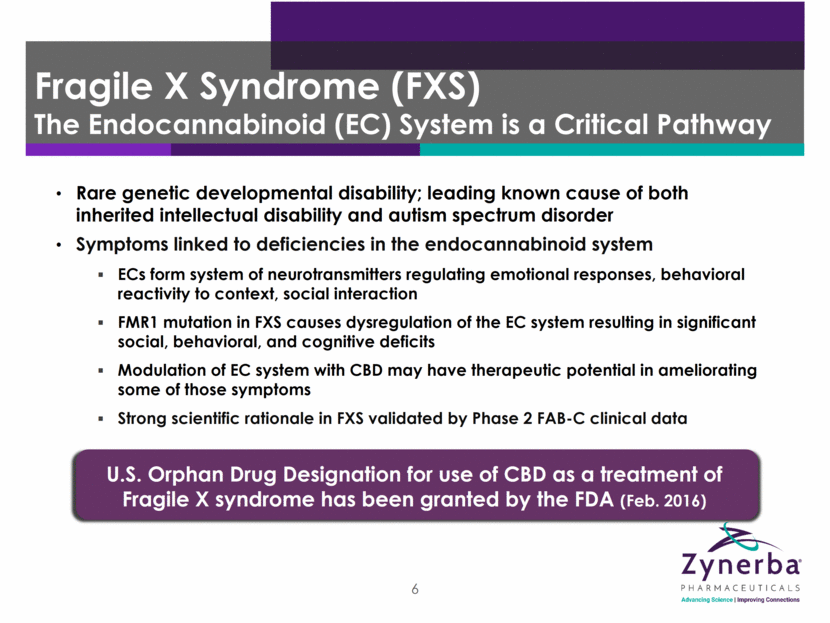
CONNECT FX: a pivotal trial now underway in pediatric and adolescent FXS patients Initiated July 2018; results expected in 2H2019 With positive results, will request FDA meeting to determine acceptability of data for NDA submission* Presented significant and sustained FAB-C open label Phase 2 efficacy data at the 16th NFXF International FXS Conference (July 2018) Achieved primary and numerous secondary efficacy endpoints with statistical significance vs. baseline Significant improvements at 12 weeks were sustained through 38 weeks of treatment with ZYN002 7 Fragile X Syndrome (FXS) Overview FXS ~71,000 in U.S. patients with Fragile X Symptoms including significant behavioral, social, and cognitive deficits *Note: Subject to change due to further regulatory, clinical and other considerations.

Maintenance Dosing initiated at CBD 50 mg Daily; may be titrated up to 250 mg daily Screening Titration Weeks 7 to 12 Day 1 to Week 6 Doses of CBD 50 mg, 100 mg, or 250 mg daily 20 patients enrolled Period 1 Period 2 Up to 24 Months Extension Patients continue on maintenance dose Physician can titrate up or down FAB-C Open Label Phase 2 (6 to 17 y.o.) Ongoing; 12 of 13 patients still enrolled 8 Completed September 2017 8 18 Patients Completed 12 Weeks
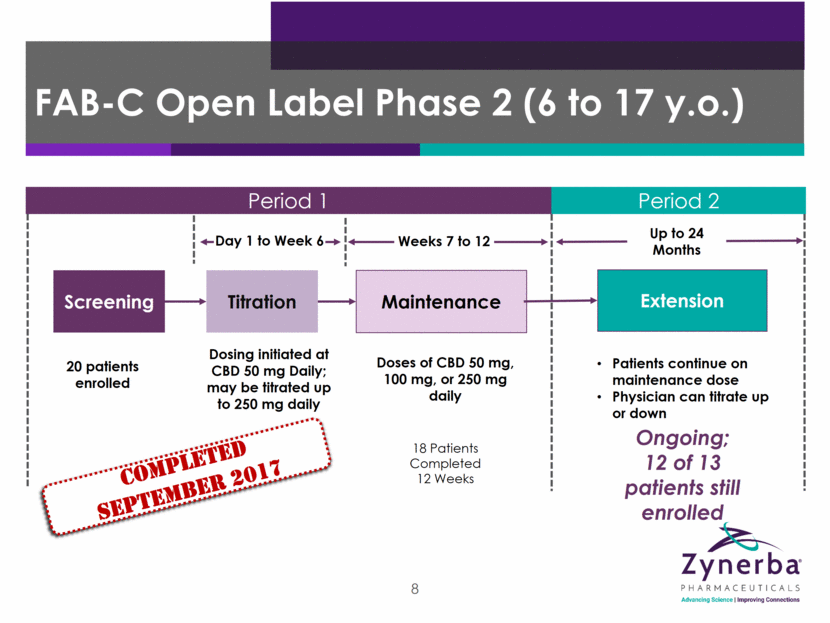
9 Scale: ADAMS Baseline (n=20) Week 12 (n=18) Week 12 % Improvement Group Mean P-value vs baseline Total Score 33.4 18.1 45.8 <0.0001 General Anxiety 10.0 4.6 54.0 <0.0001 Social Avoidance 10.2 4.8 52.9 0.0002 Compulsive Behavior 2.8 1.4 50.0 0.0262 Manic/Hyperactive Behavior 9.4 6.1 35.1 0.0003 Depressed Mood 2.8 2.0 28.6 0.1417 FAB-C 12-Week Efficacy Data: ADAMS
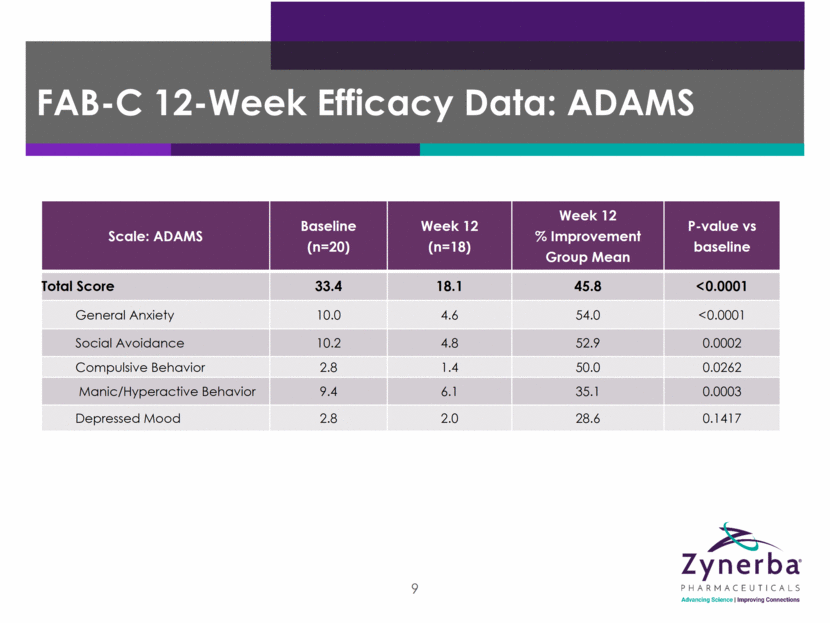
10 Scale: ABC-CFXS Baseline (n=20) Week 12 (n=18) Week 12 % Improvement Group Mean P-value vs baseline Stereotypy 7.9 3.2 59.5 0.0006 Social Avoidance 5.1 2.3 54.9 0.0005 Socially Unresponsive/Lethargic 8.7 4.1 52.9 0.0034 Inappropriate Speech 6.1 3.5 42.6 0.0018 Irritability 18.2 10.6 41.8 0.0096 Hyperactivity 14.5 9.8 32.4 0.0237 FAB-C 12-Week Efficacy Data: ABC-CFXS
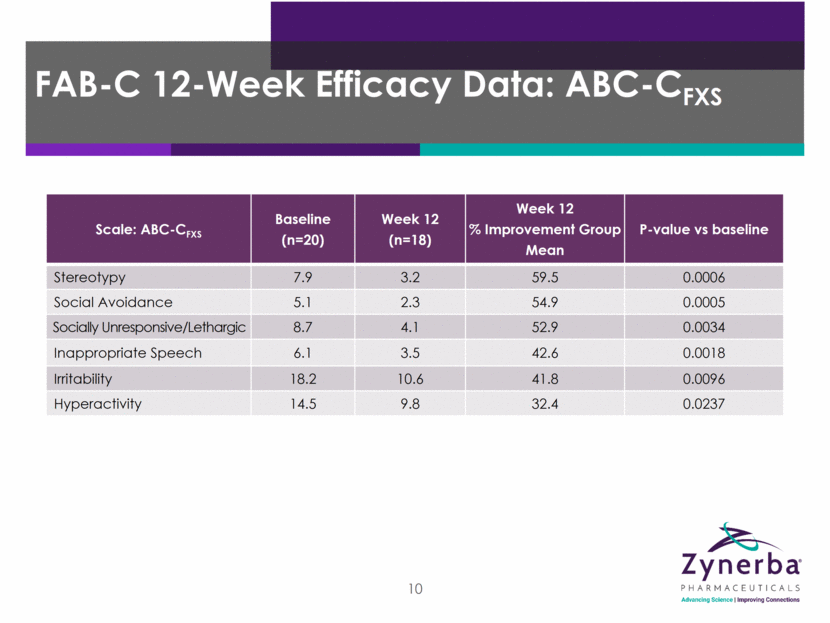
11 Irritability Temper Tantrums Hyperactivity Disrupts Group Activities Socially Unresponsive / Lethargic Does Not Pay attention Social Avoidance Seeks Isolation Stereotypy Repetitive Movements Baseline: 18.2 Baseline: 18.9 19.6 Baseline: 14.5 Baseline: 13.9 13.9 Baseline: 8.7 Baseline: 6.6 6.9 Baseline: 5.1 Baseline: 3.5 3.1 Baseline: 7.9 Baseline: 7.4 7.1 Inappropriate Speech Repeats Words / Phrases Baseline: 6.1 Baseline: 6.0 6.3 * Ligsay, A., Van Dijck, A., Nguyen, D. V., Lozano, R., Chen, Y., Bickel, E. S., et al. (2017). A randomized double-blind, placebo-controlled trial of ganaxolone in children and adolescents with fragile x syndrome. Journal of Neurodevelopmental Disorders, 9:26. 41.8% 17.9% 16.9% 32.4% 11.5% 18.7% 52.9% 17.4% 15.2% 54.9% 9.7% 31.4% 59.5% 9.9% 23.0% 42.6% 15.9% 15.0% FAB-C ABC-CFXS Subscales Week 12: Percent Improvement vs. 3rd Party Data* 0 10 20 30 40 50 ZYN002 0 10 20 30 40 Ganaxolone Placebo 0 10 20 30 40 ZYN002 0 10 20 30 40 50 60 Ganaxolone Placebo 0 10 20 30 40 50 60 ZYN002 0 10 20 30 40 50 60 Ganaxolone Placebo 0 10 20 30 40 50 60 ZYN002 0 10 20 30 40 50 60 Ganaxolone Placebo 0 10 20 30 40 50 60 ZYN002 0 10 20 30 40 50 Ganaxolone Placebo 0 10 20 30 40 50 ZYN002
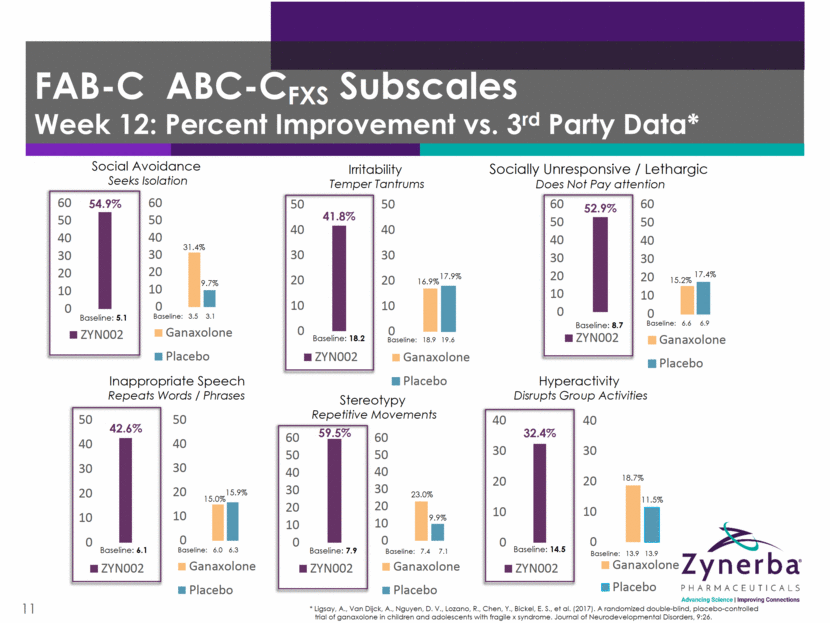
12 FAB-C Open Label Phase 2 New Data Presented at NFXF International FX Conference Treatment with ZYN002 improved core behavioral symptoms of Fragile X syndrome with statistical significance versus baseline across multiple measures of efficacy at week 12 Improvements sustained through 38 weeks of treatment ZYN002 is well tolerated No serious adverse events were reported No clinically meaningful trends in vital signs, ECG, or clinical safety laboratories, including liver function tests (LFTs) were observed No THC detected in the plasma
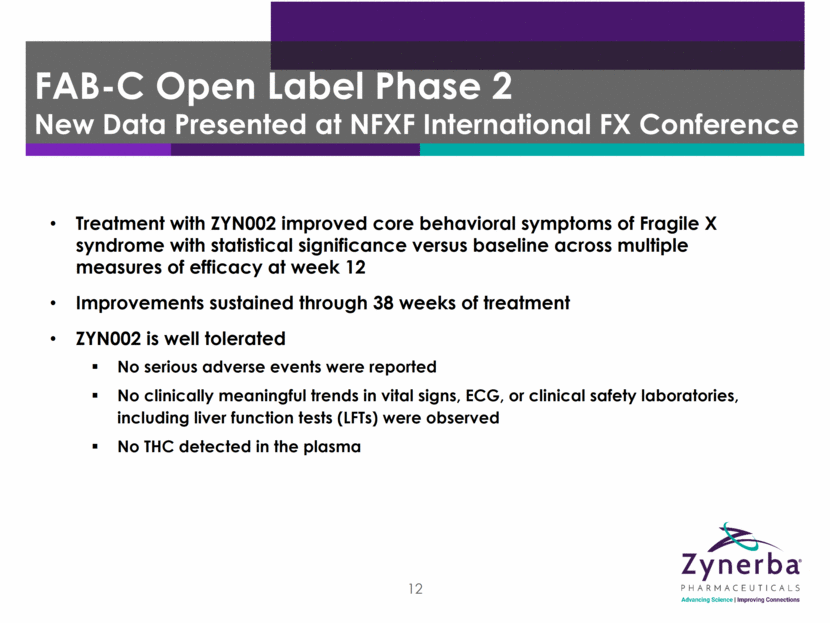
13 Scale Baseline (n=20) Week 12 (n=18) Week 12 % Improvement Group Mean P-value vs baseline Assessor CGI Improvement (7 point scale) n/a 2.5* n/a n/a Clinician Pediatric Anxiety Rating Scale – Revised (5-item used for Clinical Trials) 15.6 10.6 32.1 0.0006 Clinician Pediatric Quality of Life Inventory: Total 57.3 67.7 18.2 0.0100 Caregiver VAS Hyperactivity/Impulsivity 6.2 3.6 41.9 0.0002 Caregiver VAS Tantrum/Mood Lability 5.0 3.2 36.0 0.0023 Caregiver VAS Anxiety 6.2 3.8 38.7 0.0005 Caregiver Vineland III: Overall Adaptive Behavior 48.3 48.9 1.2 0.0472 Clinician FAB-C Open Label Phase 2 Additional 12-Week Efficacy Data * N=17 at week 12
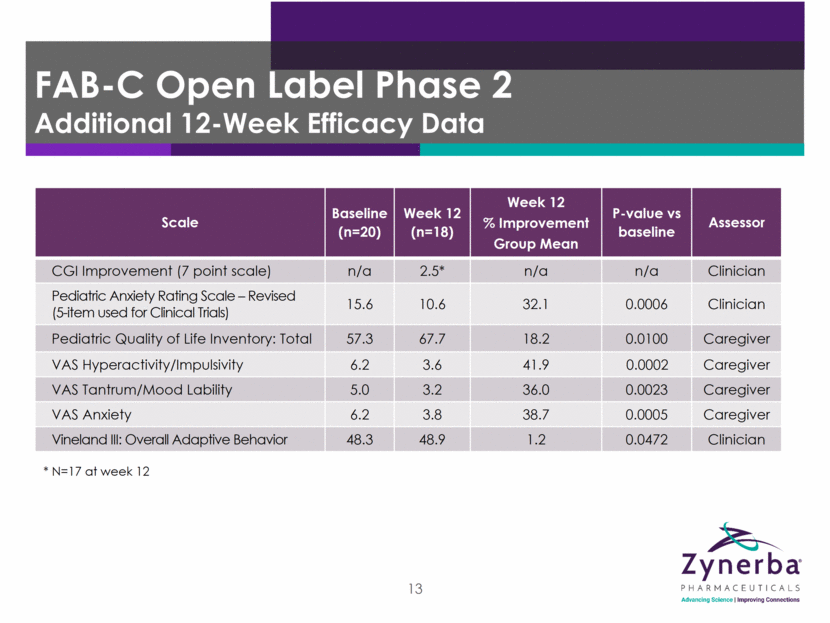
14 FAB-C Open Label Phase 2 ABC-CFXS Mean Score: 38 Weeks *P < 0.012 Mean % Improvement from Baseline Socially Unresponsive/ Lethargic Week 12 (n=12) Week 38 (n=9) Inappropriate Speech
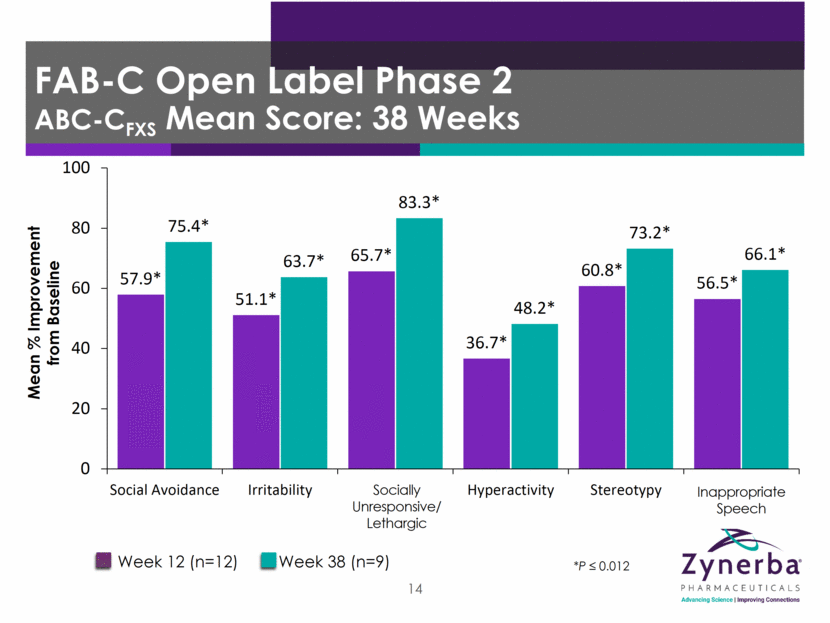
15 FAB-C Open Label Phase 2 ADAMS Mean Score: Week 38 Mean % Improvement from Baseline Manic/ Hyperactive Behavior Week 12 (n=12) Week 38 (n=12) * P < 0.0013 † P<0.038 a P = 0.083

ZYN002 Overall safety database across all studies comprised of 570 volunteers and patients Single dose to 24 months of exposure to ZYN002 FAB-C (Through 38 Weeks) Well tolerated, consistent with previously reported clinical data; no SAEs No clinically meaningful trends in vital signs, ECG, or clinical safety laboratories, including liver function tests (LFTs) No THC was detected in the plasma Two sibling patients discontinued in Period 1 of study One patient for worsening of pre-existing eczema (not considered treatment related) One patient (sibling of the patient with eczema) discontinued due to administrative reasons Application site assessment scores showed little to no redness in most patients One patient developed moderate application site rash, which resolved and did not recur; patient remains in the study FAB-C Open Label Phase 2 Safety Summary 16
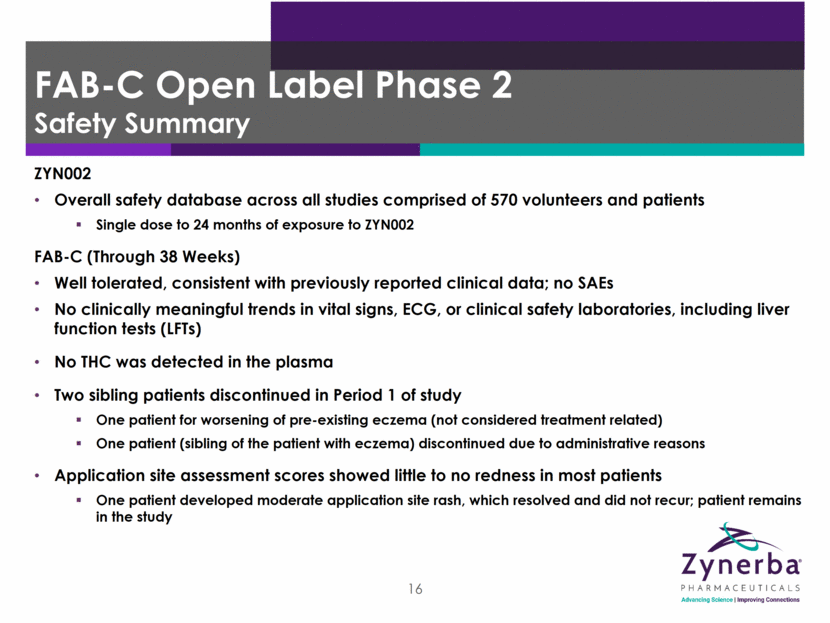
Through Week 38, patients have reported 43 treatment-emergent adverse events (TEAEs) TEAEs were mild or moderate and most unrelated to treatment with CBD Most common TEAEs (all considered not related and resolved during study period): Gastroenteritis (14%) Upper respiratory tract infection (12%) One patient developed moderate application site rash – resolved 17 FAB-C Open Label Phase 2 Treatment-Emergent Adverse Events

CONNECT-FX: A Pivotal Trial in FXS Patients Double-blind, placebo-controlled 18 Treatment Open-label extension ZYN002 250 mg daily 500 mg daily (weight-based dose) Placebo Sachets to mirror ZYN002 administration Screening Patients will be randomized (1:1) to receive either ZYN002 or placebo Target: 204 patients Clinical study of Cannabidiol (CBD) in Children and Adolescents with Fragile X (CONNECT-FX) 14 weeks 18 12 months
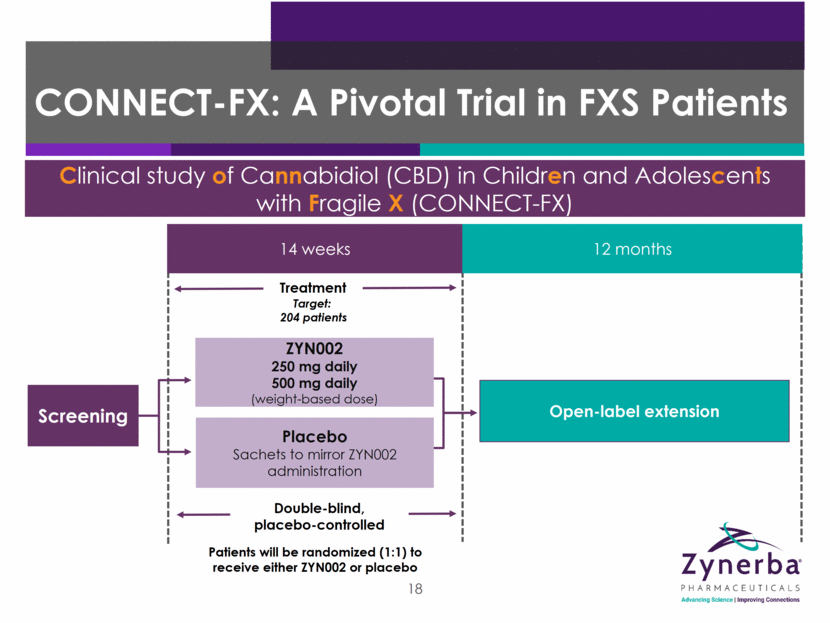
19 CONNECT-FX - Multi-national, randomized, double-blind, placebo-controlled, 14-week study 204 patients with FXS, three to 17 years of age Primary endpoint: Change from baseline to end of treatment in ABC-CFXS Social avoidance subscale Key secondary endpoints: Change from baseline to the end of the treatment period in ABC-CFXS Irritability subscale score ABC-CFXS Socially Unresponsive/Lethargic subscale score Improvement in CGI-I at the end of the treatment period. Study will anchor the CGI-I to behavioral symptoms of FXS Additional qualitative data on the clinical relevance of FXS behaviors to caregivers and patients will be collected Based on FDA’s Voice of the Patient Guidance

20 With positive results from this trial, Zynerba intends to request a meeting with the FDA to: Determine the acceptability of these data as the basis for an NDA filing Seek advice on preparation of our marketing authorization We believe ZYN002 indication may include the treatment of behavioral symptoms associated with Fragile X syndrome Evaluating opportunities for FDA fast-track, breakthrough status, and/or priority review CONNECT-FX Top Line Results Expected in 2H2019
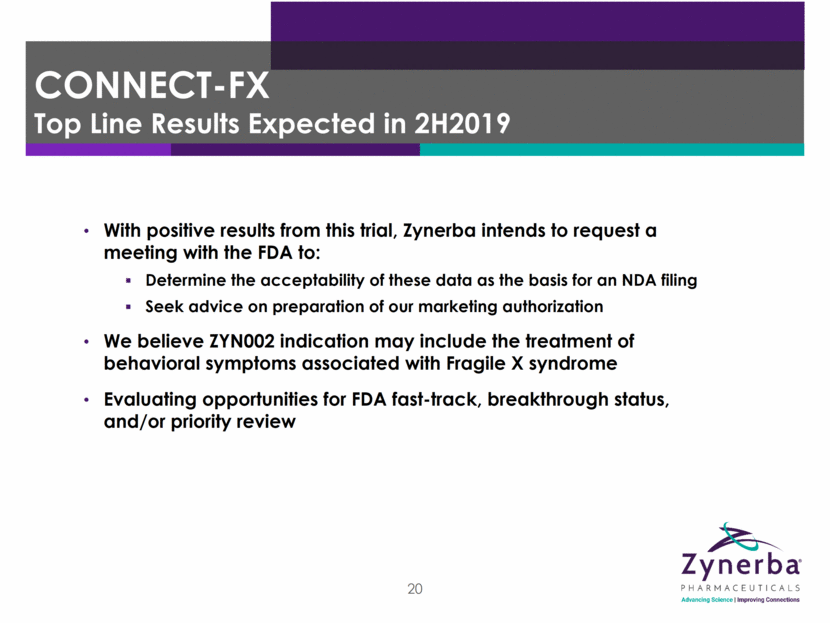
ZYN002 CBD Gel Clinical Program Developmental Epileptic Encephalopathies (DEE)
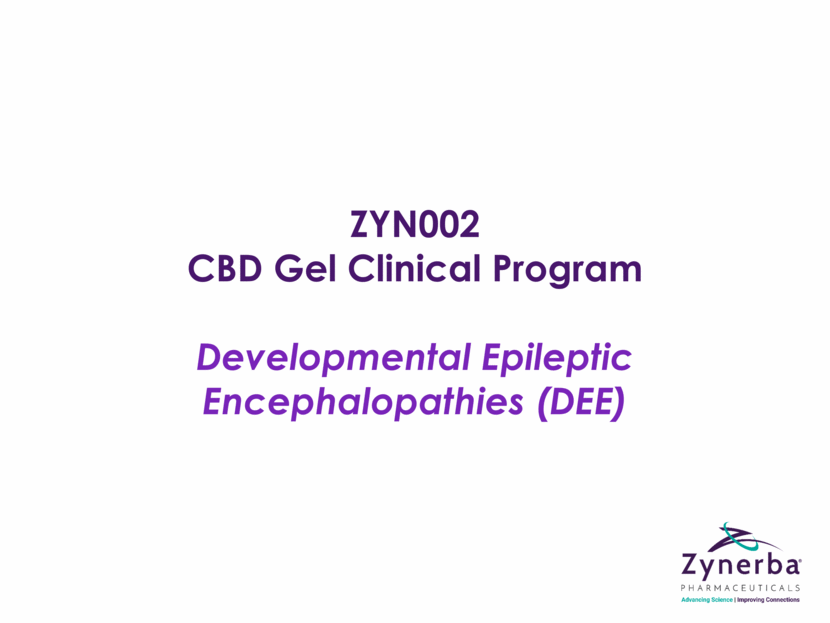
Heterogeneous group of rare and ultra rare epilepsy syndromes associated with severe cognitive impairment and behavioral disturbances ~45,000 U.S. children and adolescents with DEE Syndromes involve: Significant developmental impairment (developmental encephalopathies) Regression of developmental progress (epileptic encephalopathies) Often progressive; highly resistant to treatment Improved seizure control may have a positive impact on development and quality of life Developmental and Epileptic Encephalopathies Doose Syndrome Dravet Syndrome Early Myoclonic Encephalopathy Epilepsy of Infancy With Migrating Focal Seizures Epilepsy with Generalized Tonic-Clonic Seizures alone (EGTCS) Juvenile Myoclonic Epilepsy (JME) Landau-Kleffner Syndrome Lennox-Gastaut Syndrome Ohtahara Syndrome (Early Infantile Epileptic Encephalopathy) West Syndrome / Infantile Spasms DEE category includes: 22

Third party clinical data show impact of CBD on seizures and behavioral issues in children DEE classified by the International League Against Epilepsy (ILAE) (Scheffer et al. 2017) Patient enrollment in BELIEVE 1 Phase 2 study underway Six month multi-dose study in ~50 DEE patients (3 to <18 years) Approximately half may have either Dravet or Lennox-Gastaut syndrome Primary efficacy assessment: change in seizure frequency Results expected in 2019 23 Developmental & Epileptic Encephalopathies BELIEVE 1 New Phase 2 Program Initiated April 2018
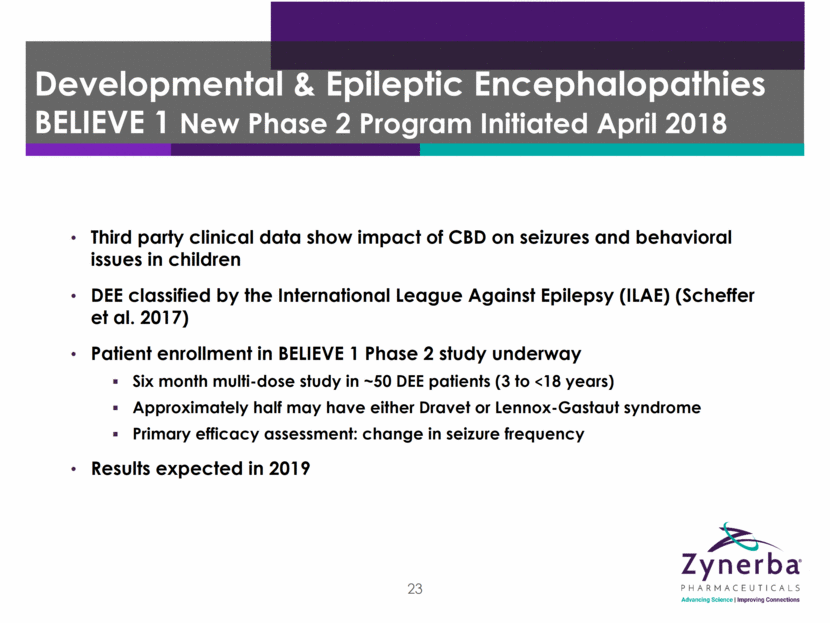
Six months 12 months BELIEVE 1 DEE Open Label Phase 2 Study Results Expected in 2019 24 *Note: Subject to change due to further regulatory, clinical and other considerations. Weight based dosing from 250 to 500 mg daily Screening Titration 2-3 week taper period Extension Target: 48 patients Study initiated April 2018; enrollment ongoing Maintenance Open Label Study to Assess the Safety and Efficacy of ZYN002 Administered as a TransdermaL Gel to ChIldren and AdolEscents with DeVelopmental and Epileptic Encephalopathy 24
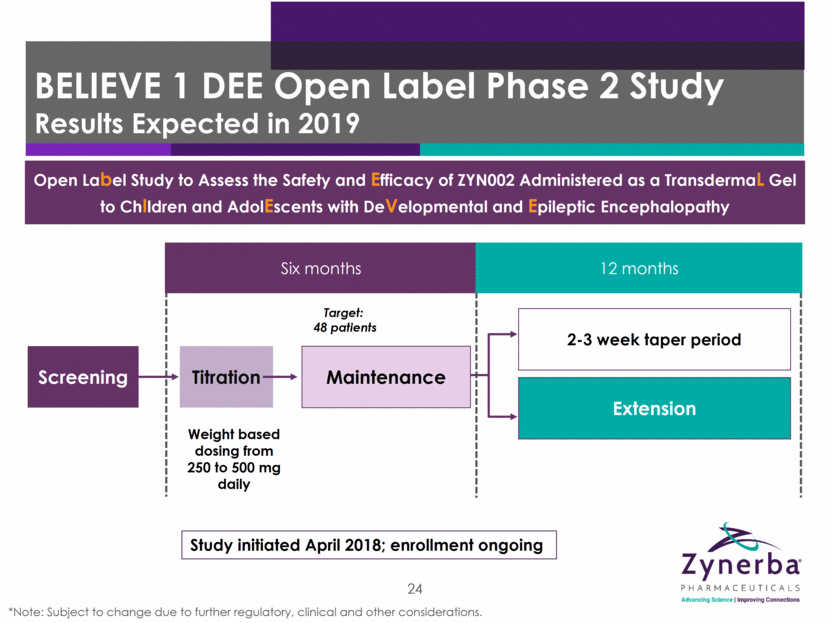
ZYN002 CBD Gel Clinical Program Adult Refractory Focal Epilepsy

STAR 2 data suggest continued improvement in seizure control in adult refractory focal seizure patients receiving ZYN002 through 12 months of open label exposure Presented in Late Breaking poster session at 2018 AAN (April 25, 2018) Learnings from Phase 2 STAR 1 study and open label STAR 2 extension provide input into Phase 2b trial design Planned modifications include increased baseline seizure frequency, patient count, and trial duration Expect to initiate ~300 patient double blind placebo controlled study in 2H2018 26 Adult Refractory Focal Epilepsy Phase 2B Study Initiation Anticipated in 2H2018 Focal seizures are the most common epilepsy in adults Substantial U.S. market ~500,000 refractory patients New treatment options with improved quality of life (safety and efficacy) needed Adult Refractory Focal Seizures
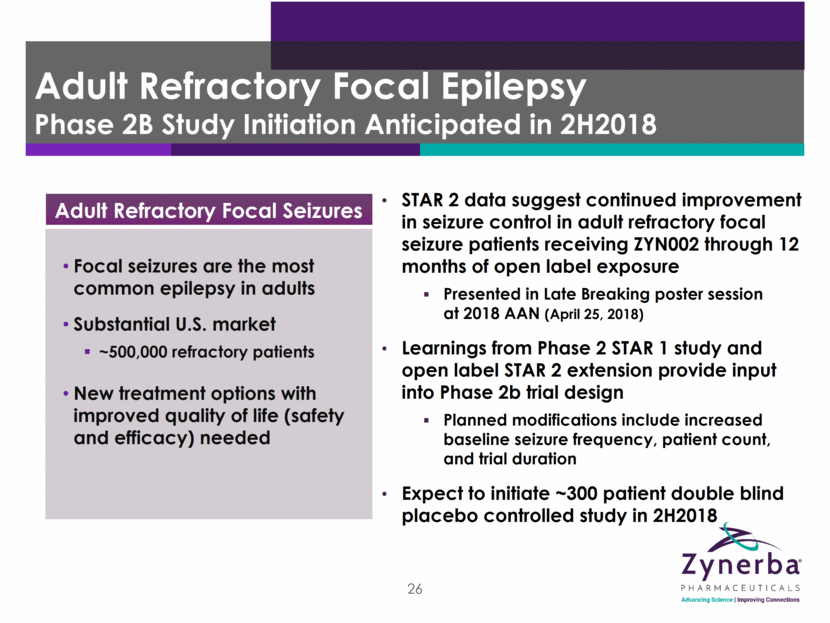
Baseline Assess seizure frequency/type Open-Label Extension Synthetic Transdermal CAnnabidiol for the TReatment of Epilepsy ZYN002 CBD 390 mg daily STAR 2 Trial STAR 1 Trial Dose can be adjusted to: 24 months 12 weeks 8 weeks Randomized (1:1:1), double-blind, placebo-controlled - 188 patients Epilepsy Phase 2 Clinical Study Trial Design Ongoing ZYN002 Low-Dose CBD 195 mg daily ZYN002 High-Dose CBD 780 mg daily Completed August 2017 ZYN002 High-Dose CBD 390 mg daily ZYN002 Low-Dose CBD 195 mg daily Placebo 27
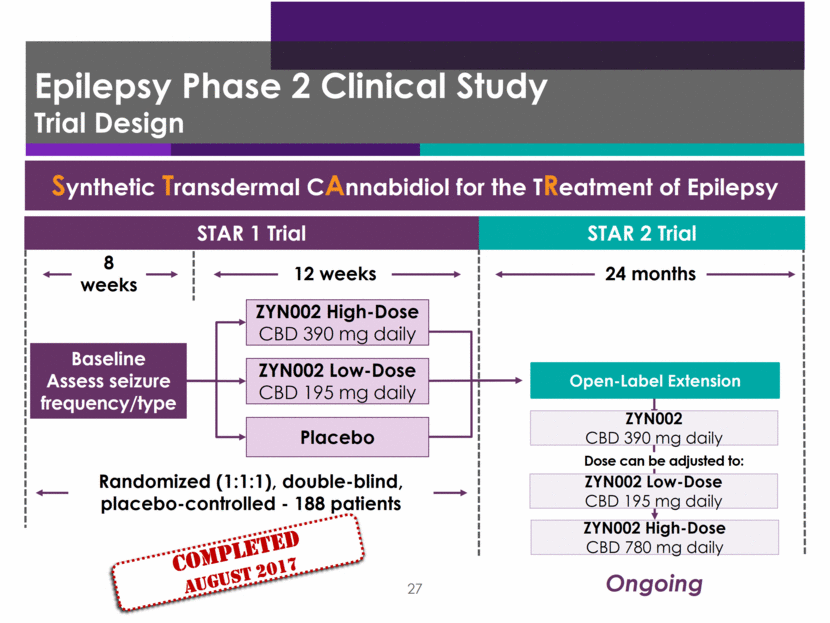
Epilepsy Phase 2 Clinical Study Demographics and Baseline Characteristics STAR 1 patients Placebo 195 mg ZYN002 390 mg ZYN002 Total Pts Randomized 63 63 62 188 Sex 43% male 57% female 51% male 49% female 42% male 58% female 45% male 55% female Pts Analyzed for efficacy 63 62 61 186 Pts completing study 62 57 55 174 Patients continuing into STAR 2 171 Baseline median seizure rate 10.5 14.0 10.1 10.6 (3-335) AEDs Median: 3.0 Mean: 2.5 Primary endpoint: Percent reduction in baseline seizures 8.7% 18.4% 14.0% 28
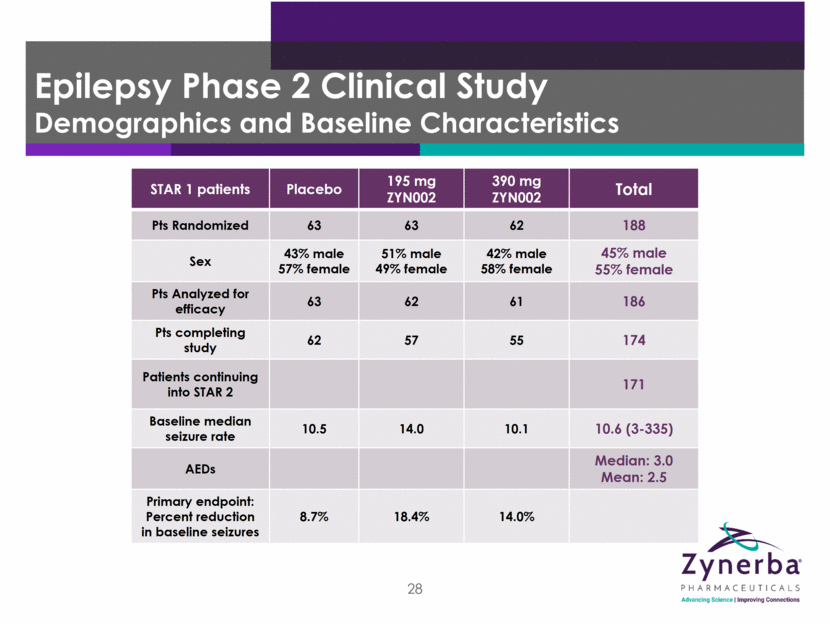
Epilepsy Phase 2 Clinical Study STAR 1 and STAR 2 Results Company believes study missed primary endpoint due to bimodal distribution of placebo patient responses : >50% reductions in focal seizures in ~¼ of placebo patients 13 of these 15 patients were female Strong separation from placebo seen at >15 baseline seizures Excellent tolerability *As of July 9, 2018 STAR 1 STAR 2 98 patients have reached 9 mo. of total drug exposure; 84 have reached 12 months* Excellent tolerability Data suggest continued improvement in seizure control with longer term use Twelve Month STAR 2 data presented during Emerging Science (Late Breaker) poster session at the 2018 American Academy of Neurology (AAN) meeting Learnings provide input into revised Phase 2B clinical trial design 29
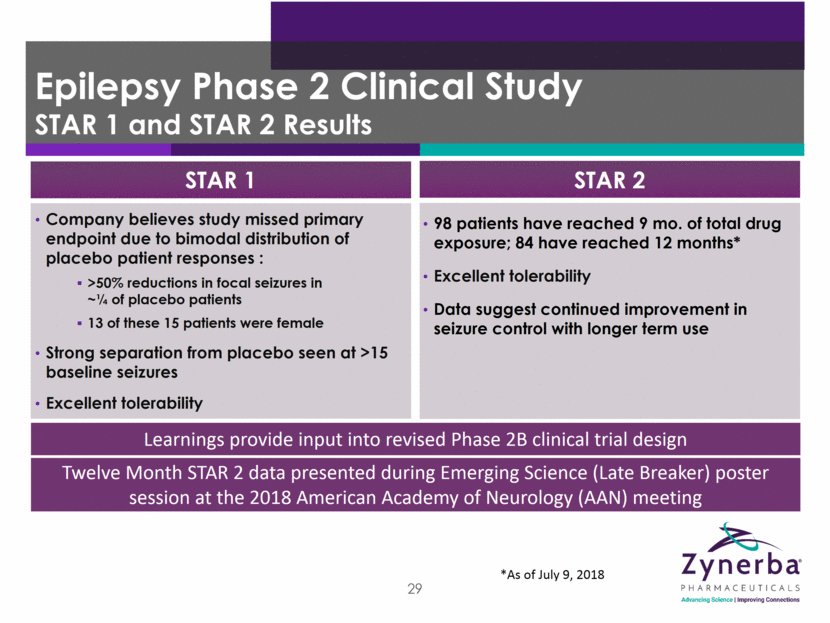
Data Presented at 2018 AAN STAR 2 Efficacy Data 30 Median Percent Change in Seizure Rates at Months 3, 6, 9, and 12 All ZYN002-Treated Patients in STAR 2 STAR 2 results based on data collected through mid-December 2017 and in patients who reported seizure frequency data during the respective time period.
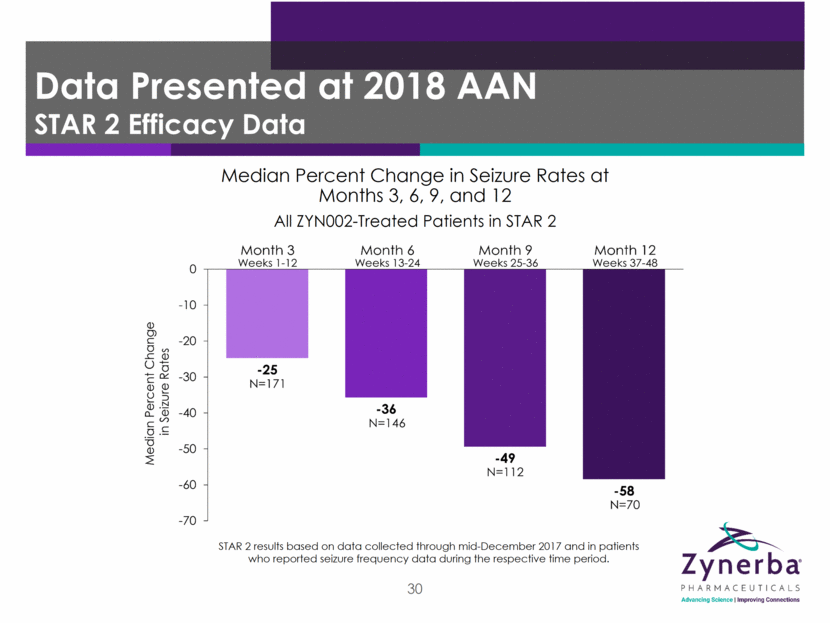
~300 patient double-blind placebo controlled study To be conducted in U.S., Australia and New Zealand Primary endpoint: reduction from baseline in focal seizures 1:1:1 ratio (195 mg: 780 mg: placebo) 31 Learnings from STAR 1 and STAR 2 experience include: Stratified randomization by baseline seizure rate and gender Increase in patient count Increase trial duration Increase in baseline seizure frequency Median seizure target: >15/month vs 10.6 in STAR 1 Trial design* Planned modifications Expect to initiate study in 2H2018 Open label extension to follow Proposed Phase 2b Study Adult Refractory Focal Epilepsy *Note: Subject to change due to further regulatory, clinical and other considerations.
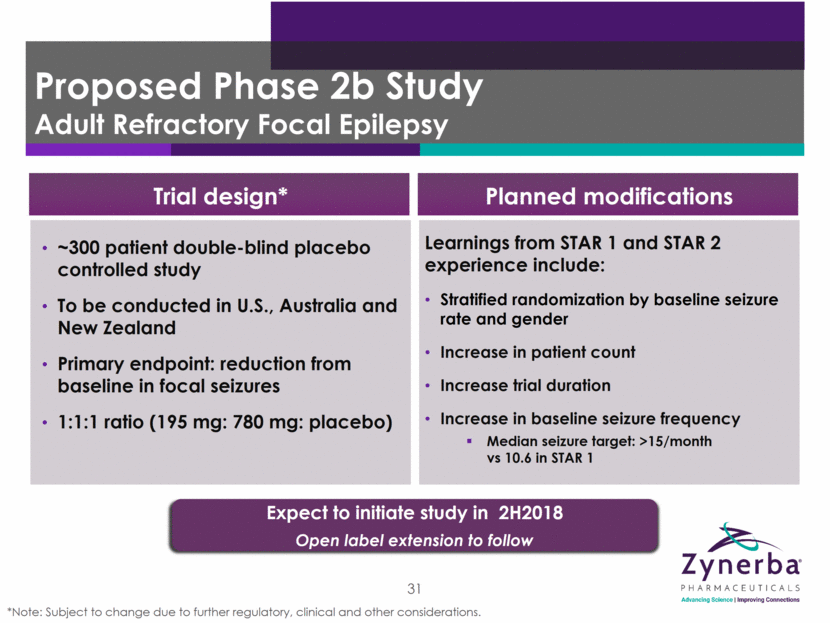
Cash and cash equivalent position of $52.1 million Well capitalized, expect cash to fund operations into 2H2019 32 Financial Strength As of March 31, 2018
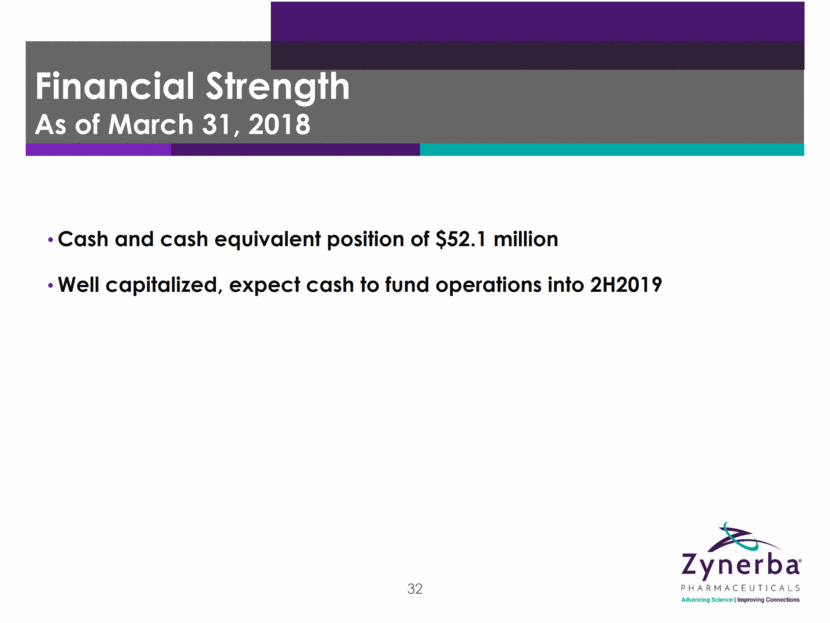
33 Expected 2018 and 2019 Milestones 1Q 2Q 3Q 4Q ZYN002 Fragile X Syndrome FDA meeting DEE Initiate Phase 2 open label study in 1H18 Adult refractory focal epilepsy Initiate new Phase 2B study in 2H18 Present/publish additional data from STAR 2 extension study in 2018 Other indications Assessment of other rare and near-rare neuropsychiatric disorders Initiate Pivotal trial Present/publish additional data from Phase 2 FAB-C study 1Q 2Q 3Q 4Q 2018 2019 Present/publish additional data from Phase 2 FAB-C study Present topline pivotal CONNECT-FX data Present top line Phase 2 BELIEVE-1 data
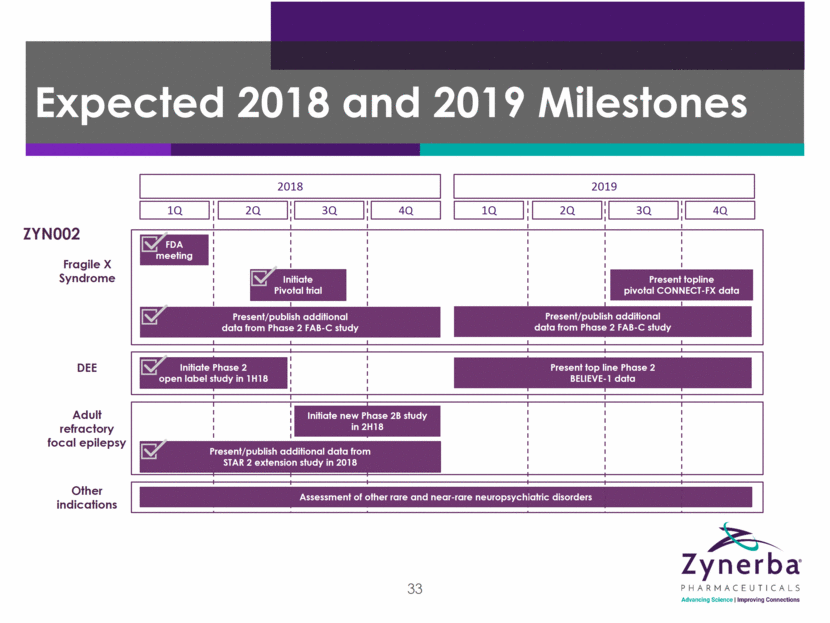
Elizabeth M. Berry-Kravis, MD, PhD Professor, Department of Pediatrics, Rush Medical College Craig A. Erikson, MD Associate Professor, Department of Psychiatry and Behavioral Neuroscience, Cincinnati Children’s Hospital Randi J. Hagerman, MD Medical Director, UC Davis MIND Institute, Distinguished Professor, Endowed Chair in Fragile X Research, Department of Pediatrics, UC Davis School of Medicine Steven J. Siegel, MD, PhD Chair, Department of Psychiatry and Behavioral Sciences, Keck School of Medicine, University of Southern California Nicole Tartaglia, MD Associate Professor, Pediatrics-Developmental Pediatrics, University of Colorado Denver School of Medicine / Children’s Hospital of Colorado Dennis Dlugos, MD, MSCE Professor of neurology and pediatrics at Children’s Hospital of Philadelphia (CHOP) and the University of Pennsylvania School of Medicine Jacqueline French, MD Professor of Neurology, NYU Langone Medical Center Daniel Friedman, MD Clinical Assistant Professor, Department of Psychiatry, NYU Langone Medical Center John Messenheimer, MD Consultant, Neurologist/Epileptologist, John Messenheimer PLLC Rodney Radtke, MD Professor of Neurology, Duke University Medical Center Michael Rogawski, MD, PhD Professor of Neurology, UC Davis Center for Neuroscience 34 Epilepsy Fragile X Syndrome Scientific Advisory Board
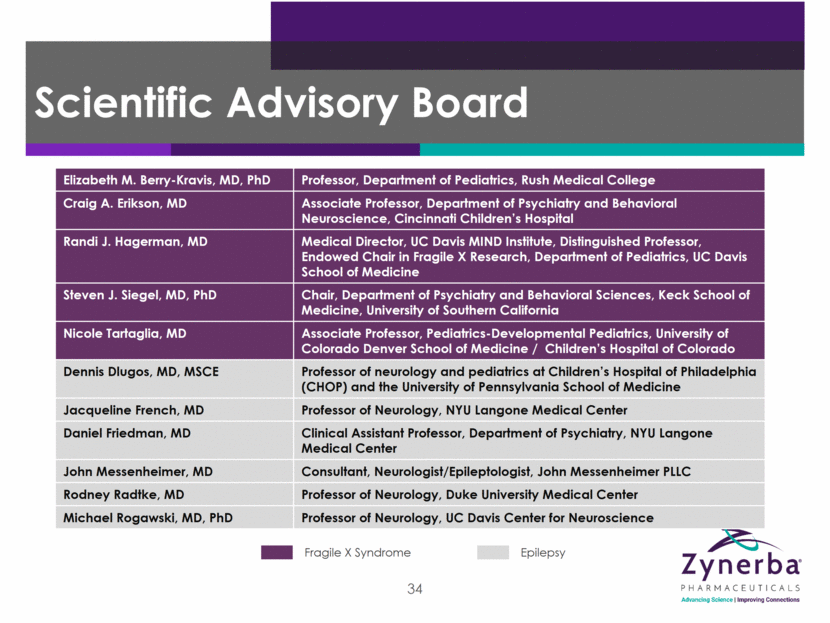
35 484.581.7505 investorrelations@zynerba.com www.zynerba.com @ZynerbaPharma Zynerba Zynerba Investor Contact Will Roberts, VP, Investor Relations and Corporate Communications 484.581.7489 NASDAQ: ZYNE Analyst Coverage* Ladenburg Thalman: Michael Higgins HC Wainwright: Oren Livnat Cantor Fitzgerald: Elemer Piros, PhD Canaccord Genuity: Arlinda Lee, PhD Seaport Global: Corey Davis Jefferies: Biren Amin, PhD * Note: Any opinions, estimates or forecasts regarding Zynerba Pharmaceuticals, Inc.’s performance made by these analysts are theirs alone and do not represent opinions, forecasts or predictions of Zynerba Pharmaceuticals, Inc. or its management. Zynerba Pharmaceuticals, Inc. does not by its reference above imply its endorsement of or concurrence with such information, conclusions or recommendations. Investor Relations

July 2018 Dedicated to the development of innovative pharmaceutically-produced transdermal cannabinoid therapies for rare and near-rare neuropsychiatric disorders
